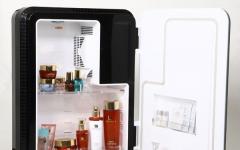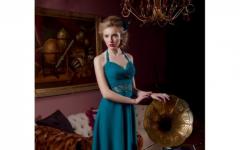Quilling is a paper twisting technique. This is a rather tedious task, but not difficult. Therefore, if desired, with the help of quillingcan be done very quickly beautiful gift or decor element - snowflakes.Quilling snowflakes can be hung on a Christmas tree, a window or just in a room, or you can stick it on greeting card or a gift box.
To make a quilling snowflake you will need:
- quilling paper;
- device for twisting tapes;
- scissors;
- centimeter or ruler;
- PVA glue.
You can buy all these materials at the craft store. There is even a special quilling kit on sale. A snowflake can also be made from the materials that are at hand, if you are on fire with the idea, and necessary materials you do not have.
Instead of quilling paper for snowflakes, take plain office or colored (double-sided) paper, and an awl will perfectly replace a thin metal crochet hook, a thin knitting needle or a wooden skewer. In this case, the paper will have to be prepared - cut into strips of the desired length and width. For a snowflake, it is best to make a strip width of 7-10 mm.
Snowflake quilling details
1st stage - creation basic elements or snowflake details. Quilling begins with mastering a few basic shapes.
1. Free spiral: tightly wind a paper tape of the required length onto the tool, then pull out the tool and let the spiral unwind a little, glue the tip of the tape to the spiral.
2. Free oval: make a loose spiral as described above and press it a little in the middle with 2 fingers to make an oval.

3. Drop: twist a tight spiral and make it free on one side, glue the end of the tape, and then press the free side.

4. Eye: make a free oval, and then press both ends of it.

In addition to these forms, there are many others with which you can create the most unusual snowflakes of any color, shape and size, both according to the scheme and independently - it all depends on your imagination.



Assembling snowflakes quilling
When all the details of the quilling snowflake are prepared, you can proceed to it. assembly. To do this, the elements are carefully glued together in accordance with the scheme. Here is one example.
1. Place a free spiral in the center. Then clearly glue 2 double-sided curls glued to the spiral from 4 sides (on the one hand, the curl is larger, on the other, less).
2. Glue loose double-sided curls into the corners of the snowflakes.

3. Glue a “drop” on the ends of the snowflake rays and in the center of each corner curl (8 pieces in total).

4. The snowflake is ready. If desired, it can be coated with a silver spray.

Snowflake quilling from white office paper
1. Take a regular sheet of A4 white office paper (2-3 pcs). Cut the strips.
2. Now take 6 strips and make "drops" out of them. Glue the "drops" together with the sharp end towards the center.
3. Then make 6 eye pieces. To do this, take 12 strips and glue them together with 2 PVA glue to make 6 long strips. Twist each into a loose spiral and form "eyes". Glue the "eyes" between the gaps of the "drops".
4. Take 6 more strips and glue “hearts” out of them: fold the strip in half, twist the edges loosely towards the center and glue the curls together. Glue the resulting parts into the gaps between the "eyes".
5. Form the following element from 6 strips: leave the middle straight (about 2 cm), and twist the ends into a tight spiral. Fix the spiral with glue, and then glue the elements to the halves of adjacent hearts.
Fold 6 strips in half, glue 2 cm from the center, twist the ends into loose spirals and glue the spirals together. Glue the details themselves to the curls made in step 5 down.
7. Glue to the ends of the received arrows on both sides in a spiral, and in the center - a “drop” with a wide part down.






The tree can be decorated. They are not at all difficult to make.
The quilling technique appeared quite a long time ago, about 500 years ago. For the first time, it began to appear in European countries. This technique involves twisting strips of paper and then gluing them together. Further, various patterns and crafts are made up of these swirling strips. Folded stripes form both closed and open shapes. Patterns are formed from simple figures, which can be both simple and whole works of art. Patterns in this technique are very airy and lacy. Therefore, today we will consider how to make an original quilling snowflake step by step. We will make an openwork snowflake that can be hung on Christmas tree or near the desktop, so that it reminds us that the holidays have come and we need to devote more time to relatives and rest.
Learning the basics of quilling technique: snowflake step by step for beginners
For its manufacture we need:- Toothpick;
- Tweezers;
- Scissors;
- Glue;
- Paper.
Let's start making a large snowflake using the quilling technique.
We take a landscape sheet and draw stripes on it with a pencil and a ruler. Make sure the lines are even. Then we cut the sheet along the drawn lines. A clerical knife can help us with this.
We take a toothpick and apply it to the edge of the strip, and then we wind the strip onto the toothpick turn by turn.
We fix the end of the strip and carefully remove the resulting roll from the toothpick.
If you do not quite understand the description of this process - do not worry, below will be presented to your attention a photo that shows step by step the process of creating basic elements.

We make another such blank, only now we squeeze one edge with our fingers. As a result of this action, we get a droplet-like element. For our composition, we repeat the above manipulations five more times.
Then we glue the resulting 6 droplets to the first figure.
Again we take a toothpick and wind more rolls and now we squeeze it on both sides so that the result is a figure in the form of an eye.
Between the petals-rays, we glue the parts we just made.
Now we take 3 strips, bend them in half and cut them, we get 6 short strips.
We miss them in the way described above.
On each tip of the part we glue a figure in the shape of an eye.
We make 6 more coils and bend them with our fingers until we get a square shape.
We glue them with the top to a large coil.
Now we wind a strip of paper around a pencil, glue the end of the paper and remove it from the pencil. This detail will act as a loop for hanging it on Christmas trees, or on whatever your heart desires.
Glue it to one of the tops of our snowflake. We stretch a ribbon or thread in the resulting ring.

As with any activity in quilling, of course, there are certain clichés or, in other words, basic elements. Let's see what they look like. There are different types of coils. Let's look at the most popular ones.
- An open coil is when the end of the strip is not attached to its body.
- Closed coil - the end of the strip is fixed, forming a closed loop.
- Tight coil - the strip is stretched very strongly throughout the twisting and tightly fixed, such a coil looks like a knot on an openwork background.
- Large coil - when creating, we use an ordinary pencil or any other thick core or frame for winding.
- Drop - press one end with your fingers.
- Eye - press both ends.
- Petal - squeeze with your fingers and bend on one side.
- Sheet - squeeze on both sides and make waves.
- Curls - fold the strip in half and wind the ends in different directions.
You can see various options for snowflake schemes in the photo below:

Quilling is the art of creating openwork patterns from paper. Translated from English quill - "bird feather". The brainchild of your creativity can be beautiful airy lace completely transparent patterns. You can create amazing compositions full of rainbow colors that evoke the mood you need. Paintings made in this technique will fit into any interior: from Gothic to high-tech, the flexibility of this art allows you to combine rigor and elegance, colorful or gloomy tones, from flowers to portraits, it depends only on the desires and scale of work: all this is possible talk about quilling. You can not only spend time with pleasure, but also for the benefit of both your interior and your wallet, because quality work has a high price.
Video selection on the topic of the article
Dear needlewomen!
Let's talk this day about snowflakes - light, airy, lacy new Year decoration. We'll show you how to create quilling snowflakes for beginners needlewomen and craftswomen. These snowflakes are especially mesmerizing. Each of their curls seems to flirt with us. The snowflake resembles a kaleidoscope, you can admire it endlessly. This kind of crafts can be glued on postcards or hung on a Christmas tree.
To create quilling snowflakes, we need:
- white office paper cut into 5 mm strips
- wooden skewer for twisting
- PVA glue
So let's get started. Before you create snowflakes, you need to prepare various figures from twisted stripes.
For the base of snowflakes, only closed forms are suitable, that is, glued.

1. Take a strip. Pull it back slightly with your fingernail and round off the end. Put a skewer on it. Then wind the strip, trying to make the first turns tighter.
2. When the paper strip "grabs" with the stick, only the stick can be rotated until the end of the strip.
3. Twist a flat washer. And to remove it, slightly rotate the wand.
4. Now dissolve the workpiece in such a way that a ring with a twisted spiral with a diameter of 12-14 mm is obtained. Most often, it is enough to simply release the workpiece. Glue the end with PVA glue.
5. In order to get the “Drop” shape, pull the middle of the spiral to one side, and on the other side, squeeze several layers so that you get a sharp end.

Other closed forms of quilling:
- Triangle shape. Make a drop shape, then grab the corner and flatten the base of the triangle.
- Eye shape. Simultaneously squeeze the round workpiece on both sides.
- "Square" shape. Make an eye shape, then rotate vertically and squeeze the sides again.
- Rhombus shape. Make this shape from "Square".
- Arrow shape. Make a “Triangle” shape and press the middle of the short side inward with the end of your index finger.
- Crescent shape. This shape is made in much the same way as the "Eye", but with a curved shape. And the corners are pinched with a shift, and not opposite each other.

Open forms of quilling:
- "Horns". Bend the strip in the middle. Screw both halves out.
- "Heart". Bend the strip in the middle. Then twist both halves inward.
- "Twig". bend paper strip in a ratio of 1: 2. Twist the ends of the strip in one direction.
- "Curl". Lightly mark the middle of the strip, but do not fold. Then twist the ends to the middle, but only in different directions.

Now that we know how to make separate shapes, let's collect snowflakes! We glue the necessary parts together.
A ruler with round holes is needed so that our spirals are of the same diameter. You can buy a regular ruler with holes in an office supply store. Although this ruler is not needed for our snowflake. It is worth noting that you can twist the strips with different tools. You can use an awl, a special slotted rod, a toothpick.
And now we will make an openwork and airy one with our own hands.
quilling snowflake.
So, for the snowflake we need:
- Paper strips:
1 - 15 cm for the central circle
8 - 8.5 cm for sleeve
4 - 15 cm for scrolls
4 - 7.5 cm for droplets
4 - 5 cm for diamonds
The standard strip width is 3mm. The paper should be fairly thick (paper weight should be at least 60 grams per square meter) so that it folds neatly and holds its shape. If you have a shredder, then the strips can be made directly on it. - Any quick-drying glue, preferably not very liquid
- Special tool for quilling. The most common alternatives are the gypsy needle or the most common wooden toothpick.
 0
We start from the central circle (15 cm strip). The paper needs to be folded very tightly so that it itself can hold correct form. After that, drip glue on the tip of the strip and glue it to the circle.
0
We start from the central circle (15 cm strip). The paper needs to be folded very tightly so that it itself can hold correct form. After that, drip glue on the tip of the strip and glue it to the circle.  0
0
 0
For droplets, we use strips 7.5 cm long. The technique is almost the same as in the previous step, only at the end, before gluing the edge, we leave a little more free space and give the circle the shape of a droplet.
0
For droplets, we use strips 7.5 cm long. The technique is almost the same as in the previous step, only at the end, before gluing the edge, we leave a little more free space and give the circle the shape of a droplet.  0
We make rhombuses from strips 5 cm long. We twist small circles, glue the edge and then make a rhombus out of it.
0
We make rhombuses from strips 5 cm long. We twist small circles, glue the edge and then make a rhombus out of it.  0
Let's move on to scrolls. We bend the strips 15 cm long in half and turn the spirals towards the center, we should get a kind of hearts.
0
Let's move on to scrolls. We bend the strips 15 cm long in half and turn the spirals towards the center, we should get a kind of hearts.  0
The last piece is the sleeves. For them, we use strips of 8 cm. On the one hand, we make 2 turns, on the other, we weld about 2.5 centimeters. When all the sleeves are ready, we glue them with “backs”.
0
The last piece is the sleeves. For them, we use strips of 8 cm. On the one hand, we make 2 turns, on the other, we weld about 2.5 centimeters. When all the sleeves are ready, we glue them with “backs”.  0
0
 0
0
- After all the preparations, we should have:
- 1 circle
- 4 drops
- 4 diamonds
- 4 scrolls
- 4 sleeves
 0
Now that all the parts are ready, we glue our snowflake together step by step. After the snowflake is ready, it can be covered with glitter or a silver-colored spray.
0
Now that all the parts are ready, we glue our snowflake together step by step. After the snowflake is ready, it can be covered with glitter or a silver-colored spray.  0
0
 0
0
 0
0
 0
0
 0
0

You can leave the snowflakes white. Or you can cover them with a spray can or sprinkle with sparkles.
You can hang a snowflake with a beautiful ribbon or a colorless fishing line.

Snowflakes can be made from white paper and spray-painted with paint of the desired color. And you can make snowflakes out of colored paper.
Colored snowflakes (quilling)


More photos beautiful snowflakes in this beautiful technique from Stephanie Sanchez:




Please note that some snowflakes are made of two colors, but all colors are very soft, which gives the snowflakes a lace look.
Airy snowflakes and paper decorations
What technique can better convey the airiness and lightness, the openwork lace pattern of snowflakes than the quilling technique? Making snowflakes out of paper, or rather from twisted strips, resembles a mosaic or a kaleidoscope with a huge number of options. The prepared parts can be glued to the base, making postcards or panels, or they can be glued together to hang amazing lace decorations on the Christmas tree. To perform these works, you will need white office paper. It must be cut into strips 5 mm thick along the short side. It is better to cut with a clerical knife along the ruler several sheets at once. For a small amount, you can cut with scissors. You can twist the strips with different tools. You can use an awl, a special slotted rod, a toothpick. But it was for making snowflakes that we most liked working with a wooden skewer. To make a snowflake (pendant or applique), you need to prepare a variety of shapes from twisted strips. Forms can be closed, i.e. glued and open, where no glue is used. Both are suitable for applications. And for snowflake pendants, you can use only closed forms.








